Mapping Ecological Units in Mesophotic Coral Ecosystems of San Andrés Island (Southwestern Caribbean)
Abstract
:1. Introduction
2. Materials and Methods
2.1. Study Area
2.2. Data Acquisition
2.3. Analysis of Biological Data
2.3.1. Image Analysis and Processing
2.3.2. Identification and Spatialization of Ecological Units
3. Results
3.1. Community Analysis for the Mapping Process
3.2. Mesophotic Ecological Units Map
- Bioturbed sediments-calcareous algae:
- Octocorals–Mixed Corals:
- Octocorals–Sponges:
- Octocorals–Sponges–Antipatharians:
- Encrusting sponges:
4. Discussion
Supplementary Materials
Author Contributions
Funding
Institutional Review Board Statement
Informed Consent Statement
Data Availability Statement
Acknowledgments
Conflicts of Interest
References
- Hinderstein, L.M.; Marr, J.C.A.; Martinez, F.A.; Dowgiallo, M.J.; Puglise, K.A.; Pyle, R.L.; Zawada, D.G.; Appeldoorn, R. Theme Section on “Mesophotic Coral Ecosystems: Characterization, Ecology, and Management”. Coral Reefs 2010, 29, 247–251. [Google Scholar] [CrossRef]
- Lesser, M.P.; Slattery, M.; Mobley, C.D. Biodiversity and Functional Ecology of Mesophotic Coral Reefs. Annu. Rev. Ecol. Evol. Syst. 2018, 49, 49–71. [Google Scholar] [CrossRef]
- Zapalski, M.K.; Berkowski, B. The Silurian Mesophotic Coral Ecosystems: 430 Million Years of Photosymbiosis. Coral Reefs 2019, 38, 137–147. [Google Scholar] [CrossRef]
- Pyle, R.L.; Copus, J.M. Mesophotic Coral Ecosystems: Introduction and Overview. In Mesophotic Coral Ecosystems; Loya, Y., Puglise, K.A., Bridge, T.C.L., Eds.; Coral Reefs of the World; Springer International Publishing: Cham, Switzerland, 2019; Volume 12, pp. 3–27. [Google Scholar] [CrossRef]
- Sinniger, F.; Ballantine, D.L.; Bejarano, I.; Colin, P.L.; Pochon, X.; Pomponi, S.A.; Puglise, K.A.; Pyle, R.L.; Museum, B.P.B.; Reaka, M.L.; et al. Biodiversity of Mesophotic Coral Ecosystems. In Mesophotic Coral Ecosystems—A Lifeboat for Coral Reefs? 1st. ed.; The United Nations Environment Programme and GRID-Arendal: Arendal, Norway, 2016; pp. 50–62, Chapter 4. [Google Scholar]
- Lesser, M.P.; Slattery, M.; Leichter, J.J. Ecology of Mesophotic Coral Reefs. J. Exp. Mar. Biol. Ecol. 2009, 375, 1–8. [Google Scholar] [CrossRef]
- Bongaerts, P.; Ridgway, T.; Sampayo, E.M.; Hoegh-Guldberg, O. Assessing the ‘Deep Reef Refugia’ Hypothesis: Focus on Caribbean Reefs. Coral Reefs 2010, 29, 309–327. [Google Scholar] [CrossRef]
- Loya, Y.; Puglise, K.A.; Bridge, T.C.L. (Eds.) Mesophotic Coral Ecosystems; Coral Reefs of the World; Springer International Publishing: Cham, Switzerland, 2019; Volume 12. [Google Scholar] [CrossRef]
- Gonzalez-Zapata, F.L.; Bongaerts, P.; Ramírez-Portilla, C.; Adu-Oppong, B.; Walljasper, G.; Reyes, A.; Sanchez, J.A. Holobiont Diversity in a Reef-Building Coral over Its Entire Depth Range in the Mesophotic Zone. Front. Mar. Sci. 2018, 5, 29. [Google Scholar] [CrossRef]
- Chasqui Velasco, L.H.; González Corredor, J.D. Peces Registrados En Ambientes Mesofóticos de Bajo Frijol, La Porción Más Somera Del Parque Nacional Natural Corales de Profundidad, Usando Buceo Técnico CCR. Bull. Mar. Coast. Res. 2019, 48, 89–101. [Google Scholar] [CrossRef]
- Sánchez, J.A.; González-Zapata, F.L.; Dueñas, L.F.; Andrade, J.; Pico-Vargas, A.L.; Vergara, D.C.; Sarmiento, A.; Bolaños, N. Corals in the Mesophotic Zone (40–115 m) at the Barrier Reef Complex From San Andrés Island (Southwestern Caribbean). Front. Mar. Sci. 2019, 6, 536. [Google Scholar] [CrossRef]
- Mejía-Quintero, K.; Chasqui, L. Octocorals and Antipatharians in the Mesophotic Rocky Reefs of Colombian Pacific (Eastern Tropical Pacific). Front. Mar. Sci. 2020, 7, 311. [Google Scholar] [CrossRef]
- Chasqui, L.; Mejía-Quintero, K.; González, J.D. Biodiversity and Ecological Units of the Mesophotic Coral Ecosystems in San Andrés Island, SeaFlower Biosphere Reserve. Front. Mar. Sci. 2020, 7, 559273. [Google Scholar] [CrossRef]
- Sánchez, J.A.; González-Zapata, F.L.; Prada, C.; Dueñas, L.F. Mesophotic Gorgonian Corals Evolve Multiple Times and Faster than Deep and Shallow Lineages. Evol. Biol. 2020; preprint. [Google Scholar] [CrossRef]
- FGDC-STD-018-2012; Coastal and Marine Ecological Classification Standard. Marine and Coastal Spatial Data Subcommittee Federal Geographic Data Committee: Reston, VA, USA, 2012. Available online: https://iocm.noaa.gov/standards/cmecs-home.html#:~:text=The%20Coastal%20and%20Marine%20Ecological,types%20of%20sensors%20and%20platforms (accessed on 20 November 2019).
- Costello, M. Distinguishing Marine Habitat Classification Concepts for Ecological Data Management. Mar. Ecol. Prog. Ser. 2009, 397, 253–268. [Google Scholar] [CrossRef]
- Loubersac, L.; Dahl, A.; Collote, P.; Lemaire, O.; D’Ozouville, L. Impact Assesment of Cyclone Sally on the Almost Atoll of Aitutaki (Cook Islands) by Remote Sensing. In Proceedings of the 6th International Coral Reef Symposium, Townsville, Australia, 8–12 August 1988; Volume 2, pp. 455–462. [Google Scholar]
- Díaz, J.M.; Barrios, L.M. (Eds.) Áreas Coralinas de Colombia; Serie Publicaciones especiales; Instituto de Investigaciones Marinas y Costeras “José Benito Vives de Andreis”, INVEMAR: Santa Marta, Colombia, 2000. [Google Scholar]
- Spalding, M.D.; Fox, H.E.; Allen, G.R.; Davidson, N.; Ferdaña, Z.A.; Finlayson, M.; Halpern, B.S.; Jorge, M.A.; Lombana, A.; Lourie, S.A.; et al. Marine Ecoregions of the World: A Bioregionalization of Coastal and Shelf Areas. BioScience 2007, 57, 573–583. [Google Scholar] [CrossRef]
- Environmental Systems Research Institute (ESRI). ArcGIS Release 10.1.; ESRI: Redlands, CA, USA, 2012. [Google Scholar]
- Howell, K.L.; Huvenne, V.; Piechaud, N.; Robert, K.; Ross, R.E. Analysis of Biological Data from the JC060 Survey of Areas of Conservation Interest in Deep Waters off North and West Scotland; Joint Nature Conservation Committee: Peterborough, UK, 2013; p. 109. [Google Scholar]
- Henry, L.-A.; Vad, J.; Findlay, H.S.; Murillo, J.; Milligan, R.; Roberts, J.M. Environmental Variability and Biodiversity of Megabenthos on the Hebrides Terrace Seamount (Northeast Atlantic). Sci. Rep. 2014, 4, 5589. [Google Scholar] [CrossRef] [PubMed]
- Rasband, W.S.; ImageJ, U.S. National Institutes of Health, Bethesda, Maryland, USA. 1997–2018. Available online: https://imagej.nih.gov/ij/ (accessed on 10 August 2022).
- Davies, J.S.; Howell, K.L.; Stewart, H.A.; Guinan, J.; Golding, N. Defining Biological Assemblages (Biotopes) of Conservation Interest in the Submarine Canyons of the South West Approaches (Offshore United Kingdom) for Use in Marine Habitat Mapping. Deep Sea Res. Part II Top. Stud. Oceanogr. 2014, 104, 208–229. [Google Scholar] [CrossRef]
- Davies, J.S.; Stewart, H.A.; Narayanaswamy, B.E.; Jacobs, C.; Spicer, J.; Golding, N.; Howell, K.L. Benthic Assemblages of the Anton Dohrn Seamount (NE Atlantic): Defining Deep-Sea Biotopes to Support Habitat Mapping and Management Efforts with a Focus on Vulnerable Marine Ecosystems. PLoS ONE 2015, 10, e0124815. [Google Scholar] [CrossRef] [PubMed]
- Clarke, K.R. Non-Parametric Multivariate Analyses of Changes in Community Structure. Austral Ecol. 1993, 18, 117–143. [Google Scholar] [CrossRef]
- Mumby, P.J. Beta and Habitat Diversity in Marine Systems: A New Approach to Measurement, Scaling and Interpretation. Oecologia 2001, 128, 274–280. [Google Scholar] [CrossRef]
- INVEMAR; CORALINA. Actualización Del Conocimiento Sobre Los Ecosistemas Sumergidos de San Andrés Isla Para La Gestión Ambiental Del Departamento Archipiélago de San Andrés, Providencia y Santa Catalina; Convenio Especial de Cooperación No. 007 de 2017; Informe técnico final; Instituto de Investigaciones Marinas y Costeras: Santa Marta, Colombia, 2018; p. 96. [Google Scholar]
- Díaz, J.M.; Garzón-Ferreira, J.; Zea, S. Los Arrecifes Coralinos de La Isla de San Andrés, Colombia: Estado Actual y Perspectivas Para Su Conservación. Revista Acad. Colomb. Ci. Exact. 1995, 7, 150. [Google Scholar]
- Reed, J.K.; Farrington, S.; David, A.; Harter, S.; Pomponi, S.A.; Cristina Diaz, M.; Voss, J.D.; Spring, K.D.; Hine, A.C.; Kourafalou, V.H.; et al. Pulley Ridge, Gulf of Mexico, USA. In Mesophotic Coral Ecosystems; Loya, Y., Puglise, K.A., Bridge, T.C.L., Eds.; Coral Reefs of the World; Springer International Publishing: Cham, Switzerland, 2019; Volume 12, pp. 57–69. [Google Scholar] [CrossRef]
- Reed, J.K.; González-Díaz, P.; Busutil, L.; Daranas, B.M.; Rojas, D.C.; Méndez, J.G. Cuba’s Mesophotic Coral Reefs and Associated Fish Communities/ Arrecifes de Coral Mesofóticos de Cuba y Comunidades de Peces Asociadas. Rev. Investig. Mar. 2018, 38, 60–129. [Google Scholar]
- Appeldoorn, R.S.; Alfaro, M.; Ballantine, D.L.; Bejarano, I.; Ruíz, H.J.; Schizas, N.V.; Schmidt, W.E.; Sherman, C.E.; Weil, E. Puerto Rico. In Mesophotic Coral Ecosystems; Loya, Y., Puglise, K.A., Bridge, T.C.L., Eds.; Coral Reefs of the World; Springer International Publishing: Cham, Switzerland, 2019; Volume 12, pp. 111–129. [Google Scholar] [CrossRef]
- Santodomingo, N.; Reyes, J.; Gracia, A.; Martínez, A.; Ojeda, G.; García, C. Azooxanthellate Madracis Coral Communities off San Bernardo and Rosario Islands (Colombian Caribbean). Bull. Mar. Sci. 2007, 81, 273–287. [Google Scholar]
- Aghajanpour, F.; Savari, A.; Danehkar, A.; Chegini, V. Combining Biological and Geomorphological Data to Introduce Biotopes of Bushehr Province, the Persian Gulf. Environ. Monit. Assess. 2015, 187, 740. [Google Scholar] [CrossRef] [PubMed]
- Porskamp, P.; Rattray, A.; Young, M.; Ierodiaconou, D. Multiscale and Hierarchical Classification for Benthic Habitat Mapping. Geosciences 2018, 8, 119. [Google Scholar] [CrossRef]
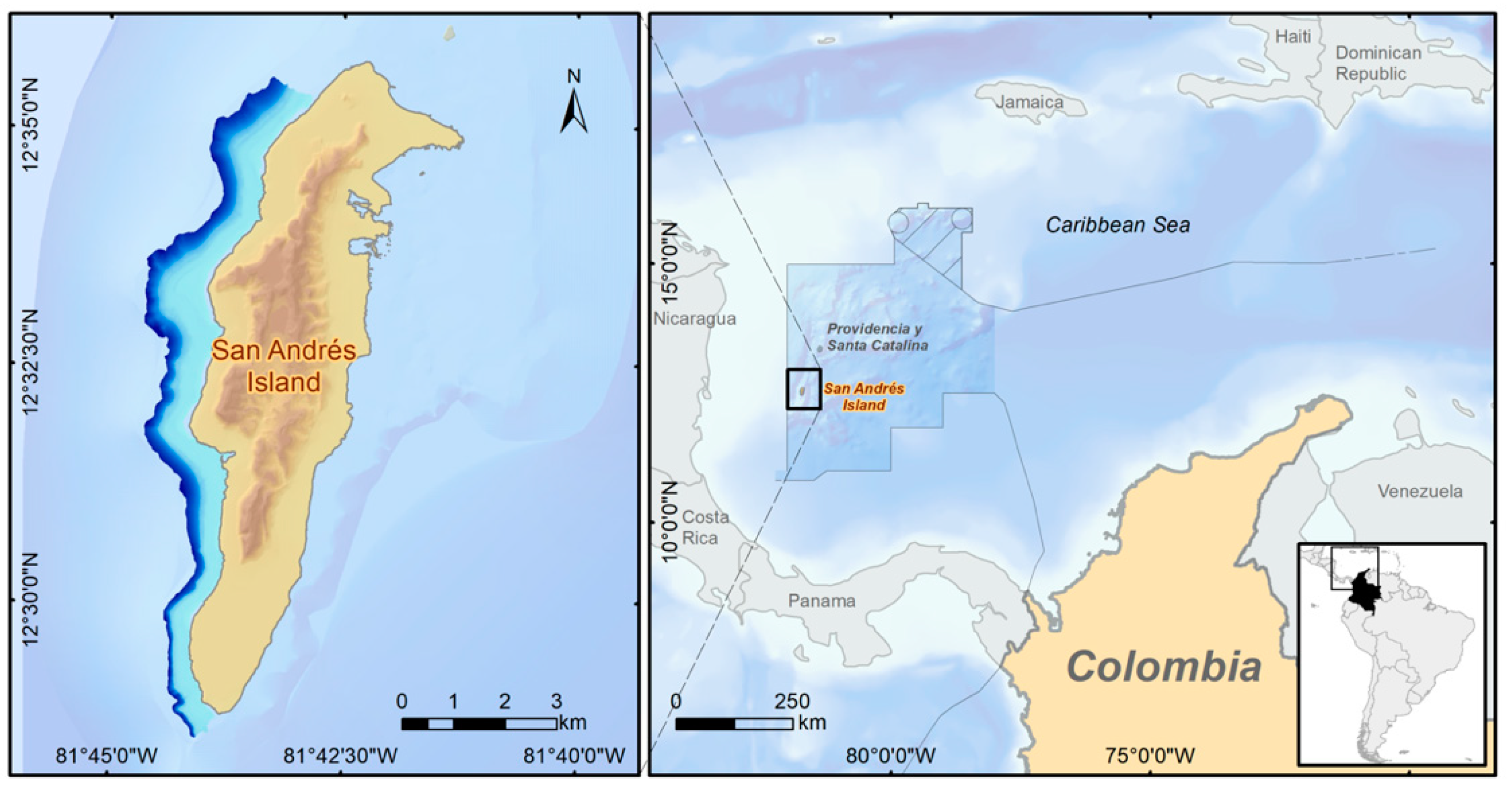
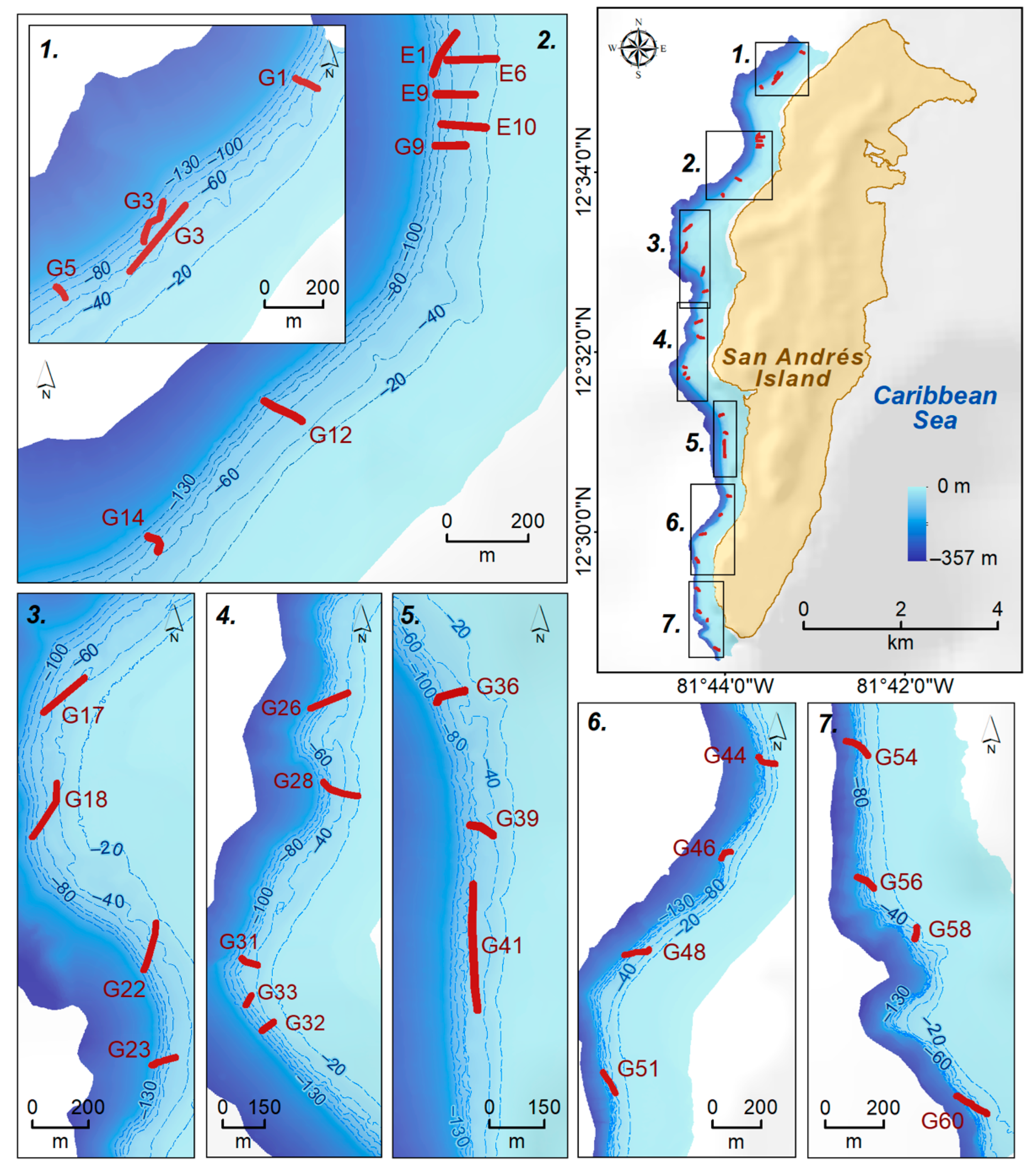
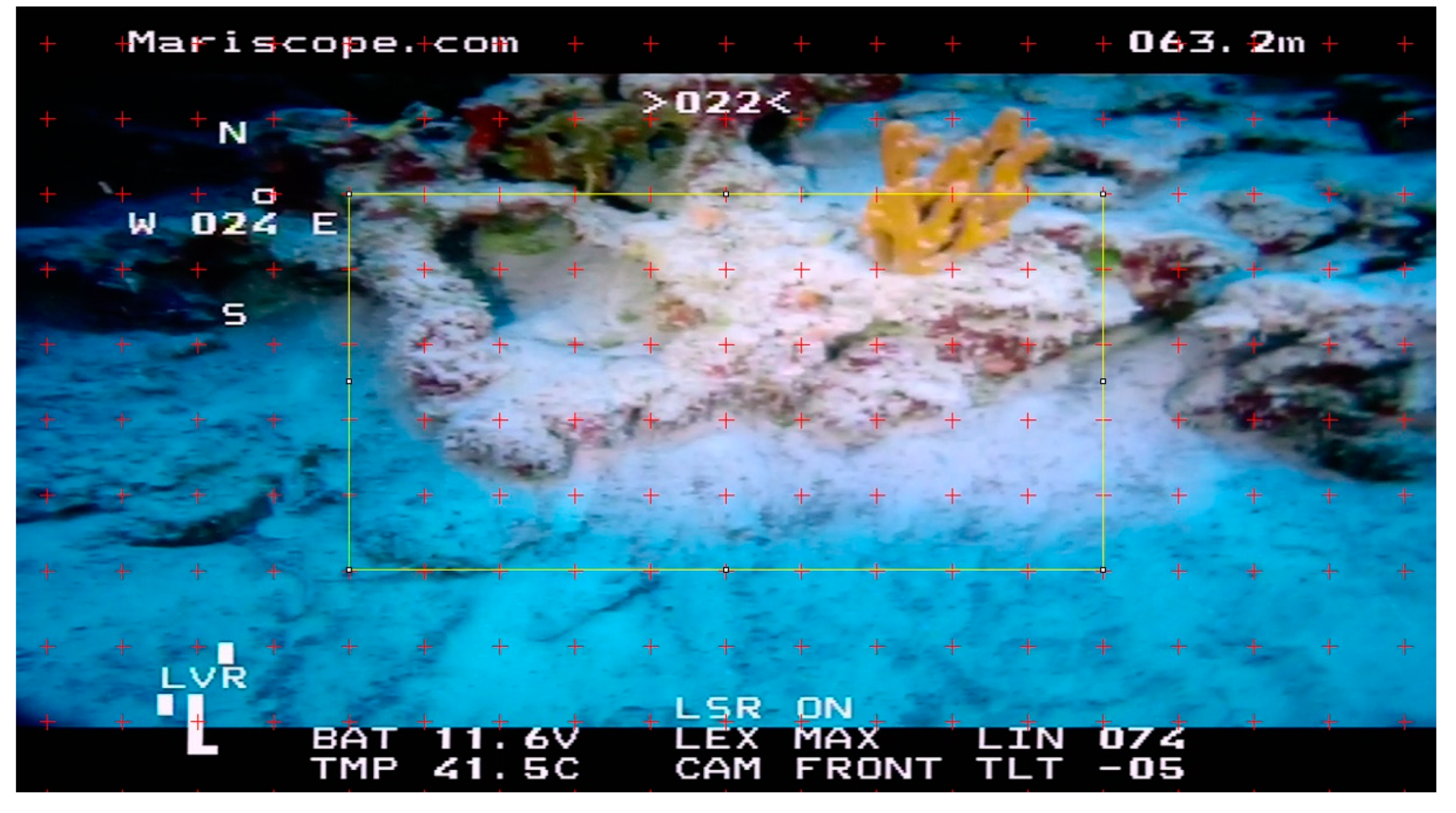
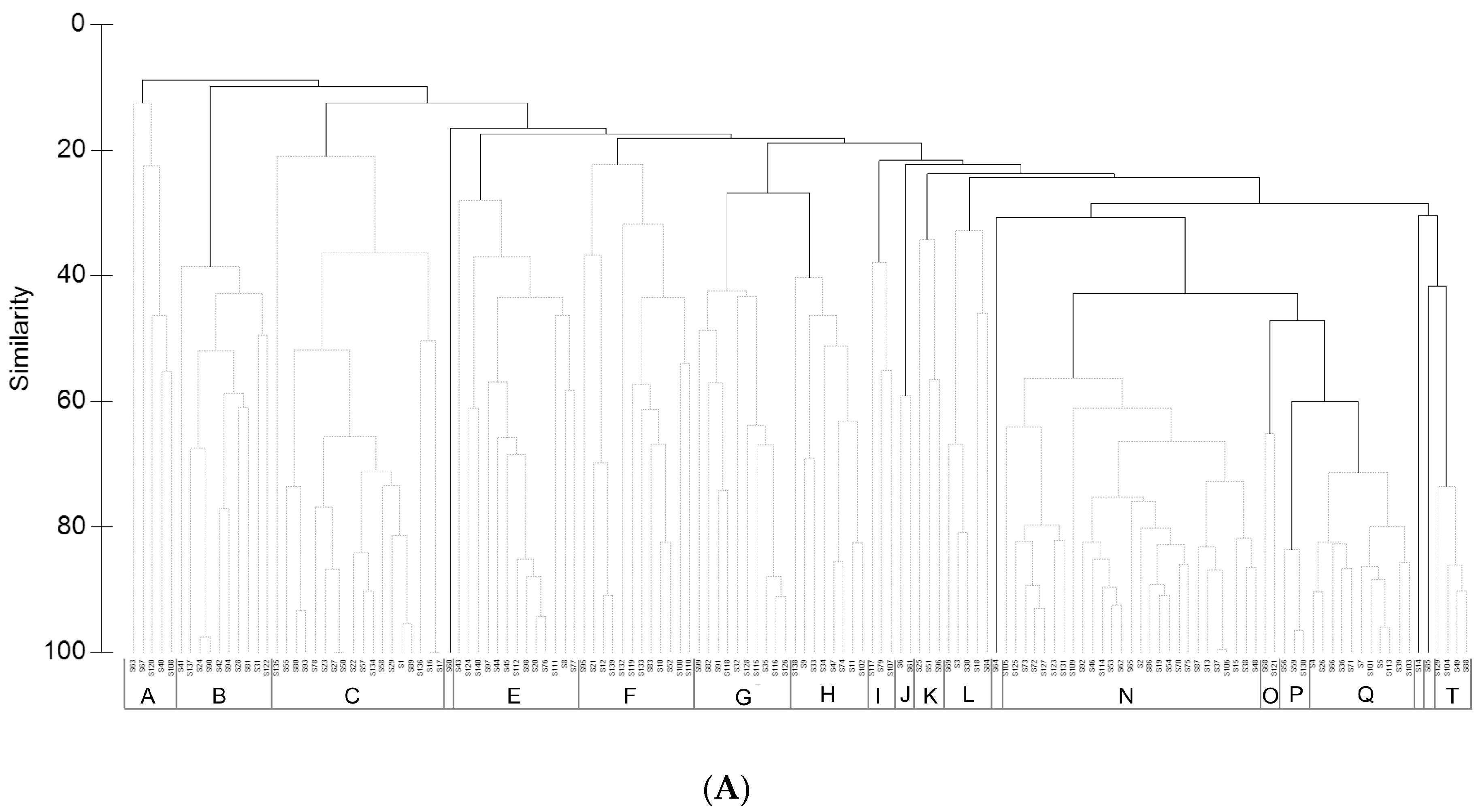
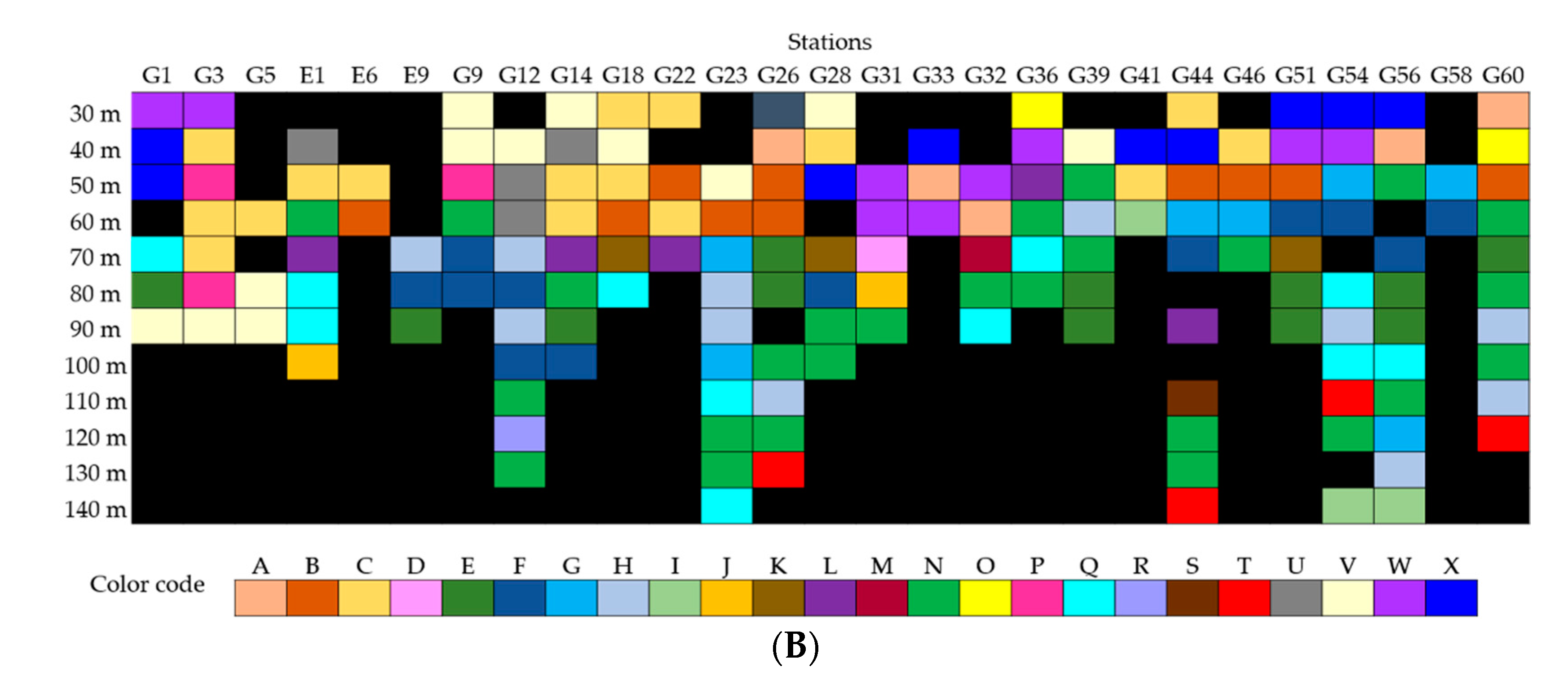
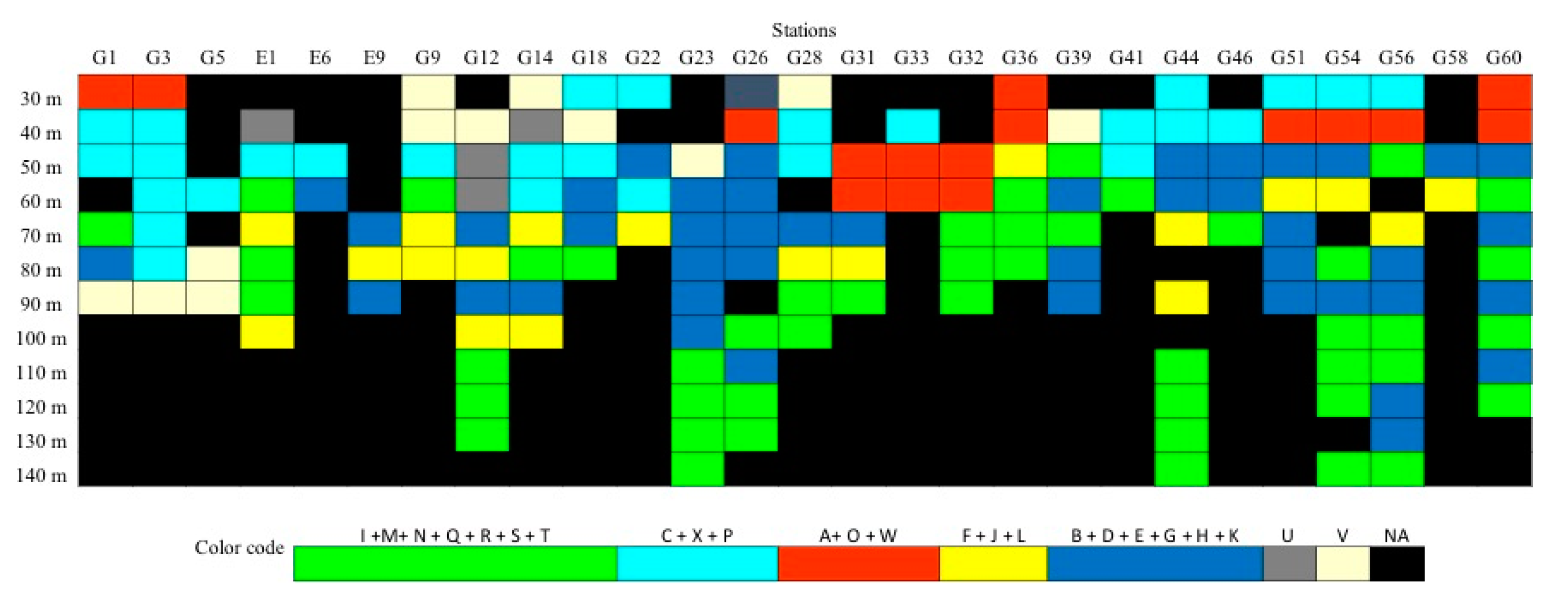
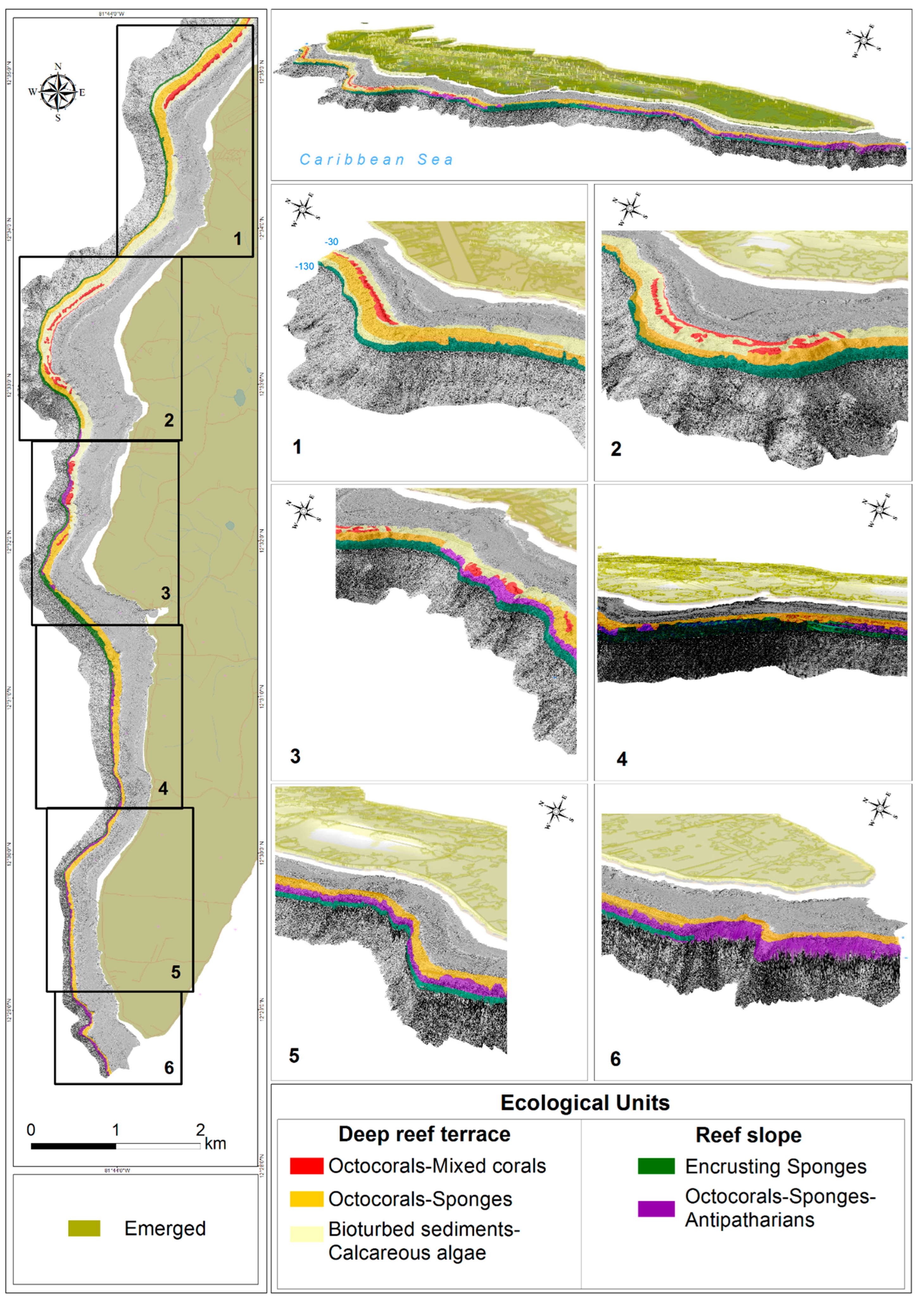
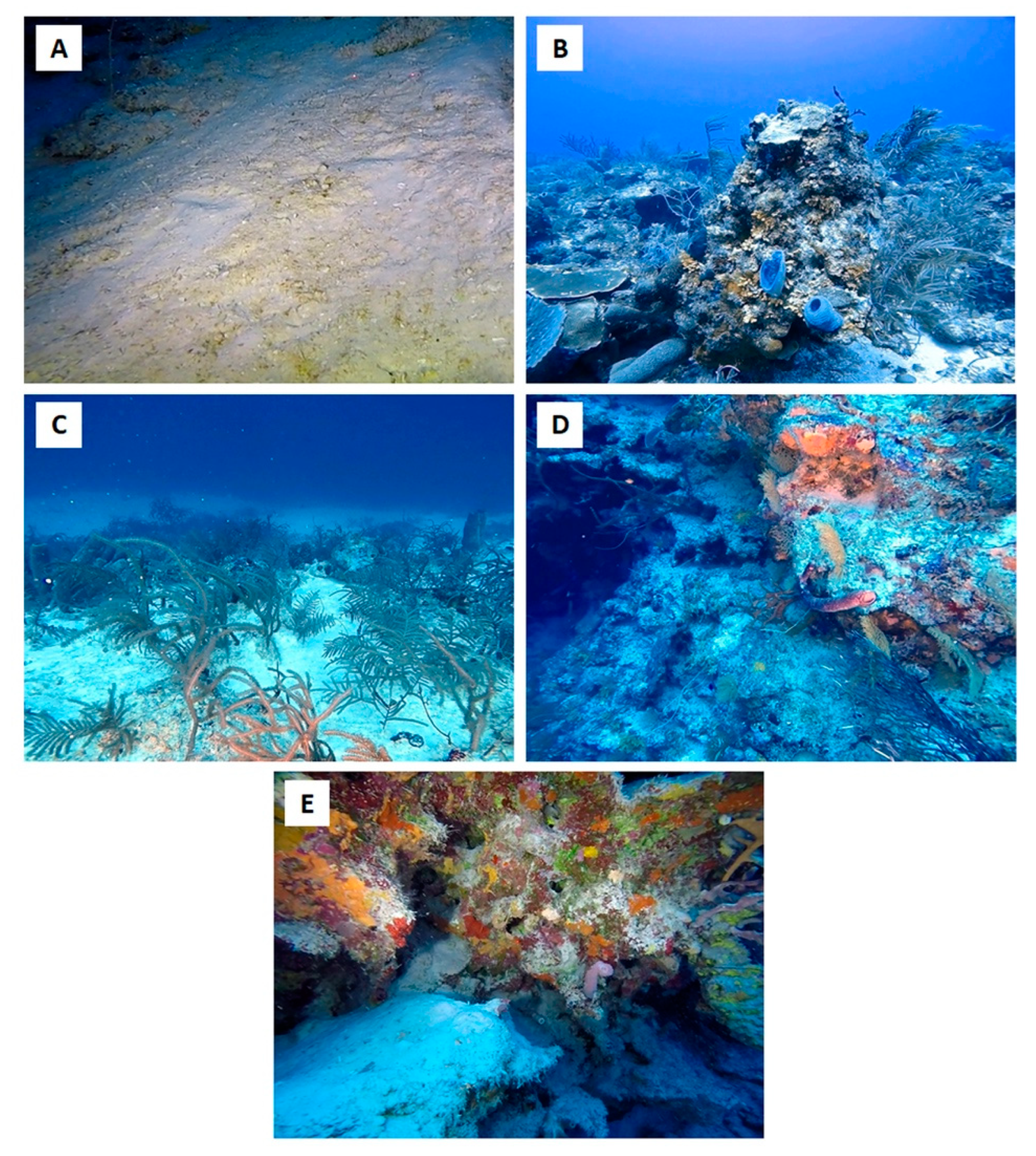
| Group | Biological Assemblage with SIMPER Analysis | Color Assigned | Biotic Unit |
|---|---|---|---|
| A | Abundance ERSP (OTU39) with patch reef and octocorals | Patch reef | |
| O | Patch reef and sand | ||
| W | Patch reef | ||
| C | Scattered coral and sand | Scattered coral and sand | |
| P | Sand and Scattered coral | ||
| X | Scattered coral | ||
| F | Abundance ERSP (Agelas sceptrum) with rocks and sand | Erect sponges with sand and rock | |
| J | Abundance ERSP (Agelas spp.) with sand | ||
| L | Abundance ERSP (Aplysina archeri) with rock and sand | ||
| B | Abundance Gorgonians (Antillogorgia sp.) with rock and sand | Octocorals and black corals with rock and sand | |
| D | Rocks and sand | ||
| E | Abundance Gorgonians (cf. Nicella sp1.) with rock and sand | ||
| G | Abundance Black corals (Stichopathes sp.) with rock and sand | ||
| H | Abundance Gorgonians (cf. Nicella sp2.) with rock and sand | ||
| K | Abundance Gorgonians (Ellisella schmitti) with rock and sand | ||
| I | Abundance ERSP (OTU49-OTU65) with green ENSP (OTU29) with rocks and sand | Encrusting sponges in rock and sand | |
| M | Encrusting sponges (OTU27, OTU28, OTU29) with sand | ||
| N | Rocks, sand, and green encrusting sponge (OTU29) | ||
| Q | Sand, rock, and green encrusting sponge (OTU29) | ||
| R | Rock, sand, and green encrusting sponge (OTU29) | ||
| S | Encrusting sponges (OTU19, OTU29, OTU36) | ||
| T | Green encrusting sponge (OTU29) and rock | ||
| U | Coral pavement | Coral pavement | |
| V | Sand | Sand |
Publisher’s Note: MDPI stays neutral with regard to jurisdictional claims in published maps and institutional affiliations. |
© 2022 by the authors. Licensee MDPI, Basel, Switzerland. This article is an open access article distributed under the terms and conditions of the Creative Commons Attribution (CC BY) license (https://creativecommons.org/licenses/by/4.0/).
Share and Cite
Mejía-Quintero, K.; Cedeño-Posso, C.; Millán, S.; Chasqui, L. Mapping Ecological Units in Mesophotic Coral Ecosystems of San Andrés Island (Southwestern Caribbean). Diversity 2022, 14, 679. https://doi.org/10.3390/d14080679
Mejía-Quintero K, Cedeño-Posso C, Millán S, Chasqui L. Mapping Ecological Units in Mesophotic Coral Ecosystems of San Andrés Island (Southwestern Caribbean). Diversity. 2022; 14(8):679. https://doi.org/10.3390/d14080679
Chicago/Turabian StyleMejía-Quintero, Katherine, Cristina Cedeño-Posso, Santiago Millán, and Luis Chasqui. 2022. "Mapping Ecological Units in Mesophotic Coral Ecosystems of San Andrés Island (Southwestern Caribbean)" Diversity 14, no. 8: 679. https://doi.org/10.3390/d14080679
APA StyleMejía-Quintero, K., Cedeño-Posso, C., Millán, S., & Chasqui, L. (2022). Mapping Ecological Units in Mesophotic Coral Ecosystems of San Andrés Island (Southwestern Caribbean). Diversity, 14(8), 679. https://doi.org/10.3390/d14080679






